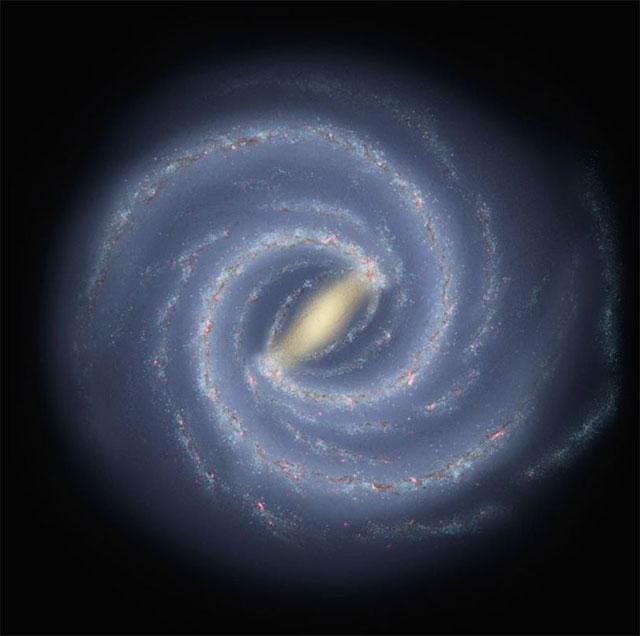Revealing new findings about the size of the galaxy
Chinese astronomers have just revealed shocking new findings about the size of the Milky Way, suggesting that our galaxy may be significantly larger than previously thought. This. The research, published in the prestigious journal Nature Astronomy, used data from the world's first major near-infrared stellar spectroscopy survey called APOGEE.
Estimated through the distribution of stars in the Milky Way
From the beginning of the research project, Associate Professor Lian Jianhui of Yunnan University and his colleagues determined that the main focus was on dust and other factors that could interfere with measurements. traditional. By analyzing the distribution of stars across the Milky Way, scientists were able to reconstruct a more complete picture of its structure.
The discovery by Lian Jianhui and his research team challenges the long-held assumption that the Milky Way has a single exponential disk – a flat structure in which the density of stars steadily decreases as it moves outward. Instead, the results of the analysis by a team of Chinese scientists showed a more complex structure. The outer disk (more than 24,000 light-years from the galactic center) appears to fit an exponential model. However, the inner disk (between 11,000 and 24,000 light-years) exhibits a flatter distribution, with relatively constant stellar density.

This new discovery has many important implications. Previous estimates based on the exponential disk model have placed the Milky Way's radius at around 10,000 light-years, making our galaxy appear denser than galaxies of similar mass. However, the new data shows a nearly double radius of 19,000 light-years, putting the Milky Way on par with other galaxies of its kind in terms of size.
Professor Lian emphasized the importance of near-infrared observations in overcoming the limitations of traditional methods. Dust particles significantly affect visible light, but their impact on near-infrared wavelengths is much smaller. This allows scientists to get a clearer picture of the distribution of stars, especially in dusty regions within the Milky Way, through near-infrared wavelengths.
This discovery provides valuable insights into the structure and characteristics of the Milky Way, prompting further research to reconsider estimates of our galaxy's overall physical properties.
You should read it
- Astronomers discovered a 'candy cane' in the center of the Milky Way
- The interaction between the Milky Way and a satellite galaxy is creating many new stars
- Discovered organic molecules that can make life in the center of the Milky Way
- See stunning works from the art of capturing miniatures with the Milky Way
- The mysterious bubble that appears in the center of the Milky Way galaxy is finally 'decoded'.
- 25 most beautiful Milky Way photos in 2020
- Do you think the Sun stands still and the Earth revolves around it? Just wrong!
- Science has discovered the fastest-flying star in the Milky Way, reaching 8% of the speed of light
May be interested
- Size of paper size A0, A1, A2, A3, A4 ... how many mm, inch?
 below is the size of a paper size (both mm and inch) in accordance with iso 216, which was introduced by the german standards institute in 2012.
below is the size of a paper size (both mm and inch) in accordance with iso 216, which was introduced by the german standards institute in 2012. - Size of paper size A0 A1 A2 A3 A4 is how many Pixel, Cm, Inches standard
 many people wonder about the size of paper sizes a0, a1, a2, a3, a4, a5, ... in cm, pixel or inch units. the following article, please refer to this section to better understand this issue.
many people wonder about the size of paper sizes a0, a1, a2, a3, a4, a5, ... in cm, pixel or inch units. the following article, please refer to this section to better understand this issue. - Galaxy M31: 4 64MP cameras, 6000mAh battery, priced from 4.9 million
 samsung has officially launched the galaxy m31, the upgraded camera version of its predecessor galaxy m30s.
samsung has officially launched the galaxy m31, the upgraded camera version of its predecessor galaxy m30s. - Official information about Samsung Galaxy S8, S8 Plus: Price, date of sale, specifications and special features
 samsung's product launch event took place in the heart of the next generation of flagship phones, samsung galaxy s8 and samsung galaxy s8 plus. the following article will summarize all information about prices, sales dates, specifications and information regarding samsung galaxy s8 and samsung galaxy s8 plus.
samsung's product launch event took place in the heart of the next generation of flagship phones, samsung galaxy s8 and samsung galaxy s8 plus. the following article will summarize all information about prices, sales dates, specifications and information regarding samsung galaxy s8 and samsung galaxy s8 plus. - Order Galaxy S20 series and receive Galaxy Buds + headphones for free
 when customers order galaxy s20 +, s20 ultra first will be immediately free a set of galaxy buds + headsets.
when customers order galaxy s20 +, s20 ultra first will be immediately free a set of galaxy buds + headsets. - List of 13 Samsung phone models with One UI 3.1 updated
 recently, samsung has officially released the one ui 3.1 update for mid-range and high-end phones. below is the one ui 3.1 updated samsung phone list
recently, samsung has officially released the one ui 3.1 update for mid-range and high-end phones. below is the one ui 3.1 updated samsung phone list - Some useful tips to take advantage of features on Galaxy S7 (P1)
 the handy tips below will help you get the most out of the samsung galaxy s7 features, making it easier to master the device.
the handy tips below will help you get the most out of the samsung galaxy s7 features, making it easier to master the device. - Revealing the size of Apple's first foldable iPhone model
 apple is developing a foldable iphone and recent leaks promise that the phone will offer a unique user experience.
apple is developing a foldable iphone and recent leaks promise that the phone will offer a unique user experience. - Some advanced Galaxy S20 features are about to be updated for Galaxy S10 and Note10
 samsung has confirmed that it will bring some 'exclusive' features of the galaxy s20 to the galaxy s10 and galaxy note10 series through software updates, ensuring that owners of previous-generation flagship models still have the opportunity. experience early useful new features.
samsung has confirmed that it will bring some 'exclusive' features of the galaxy s20 to the galaxy s10 and galaxy note10 series through software updates, ensuring that owners of previous-generation flagship models still have the opportunity. experience early useful new features. - Samsung Galaxy A32 launched in India
 after introducing the galaxy a32 last week, samsung has officially launched a new rookie of the mid-range galaxy a phone line in india.
after introducing the galaxy a32 last week, samsung has officially launched a new rookie of the mid-range galaxy a phone line in india.









 Scientists have released detailed images of an asteroid that just passed Earth at close range
Scientists have released detailed images of an asteroid that just passed Earth at close range Admire the colorful moment of a star in the making
Admire the colorful moment of a star in the making Admire stunning images showing the strange phenomenon of the Serpens Nebula
Admire stunning images showing the strange phenomenon of the Serpens Nebula Strange discovery: The famous star that has been observed a lot so far turns out to be a pair of twins
Strange discovery: The famous star that has been observed a lot so far turns out to be a pair of twins Satellites captured unprecedented images of a giant piece of space junk
Satellites captured unprecedented images of a giant piece of space junk Why is it rare to see pilots with beards?
Why is it rare to see pilots with beards?